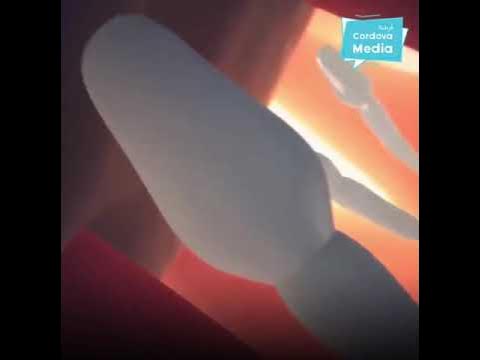Fertilization
Summary
TLDRThe script narrates the miraculous journey of fertilization, where 300 million sperm compete to unite with an egg, forming a new life. Through various obstacles such as the acidic vagina, cervical mucus, and immune system defenses, only a few dozen reach the egg. The first sperm to penetrate the egg triggers a series of reactions that prevent further penetration, leading to the formation of a zygote with a unique genetic code. This marks the beginning of a new human life, which will develop in the uterus over nine months.
Takeaways
- 🌟 Fertilization is the process where a single sperm unites with an egg to form a new human life, representing the beginning of all of us.
- 💧 During sexual intercourse, approximately 300 million sperm are introduced into the vagina, facing significant challenges from the start.
- 🚫 Many sperm are lost due to the vagina's acidic environment or by simply flowing out, with only a fraction surviving thanks to protective elements.
- 🔄 The sperm must navigate through the cervix and into the uterus, where the cervix is open for a few days during ovulation to facilitate passage.
- 🌀 Uterine contractions aid the sperm's journey, but the woman's immune system cells mistakenly target and destroy thousands of them.
- 🌐 Half of the sperm head towards an empty fallopian tube, while the other half swim towards the tube with the unfertilized egg.
- 🏋️♂️ Sperm must swim against the motion of tiny cilia in the fallopian tube that push the egg towards the uterus, with some getting trapped and dying.
- 🔄 Chemical changes in the reproductive tract activate the sperm, causing them to swim harder and faster towards the egg.
- 🥇 Only a few dozen sperm reach the egg, where they must penetrate the corona radiata and the zona pellucida to fertilize it.
- 🔒 The first sperm to reach the egg triggers a series of reactions that prevent other sperm from attaching and harden the zona pellucida, ensuring fertilization by only one sperm.
- 🧬 Inside the egg, the male genetic material combines with the female genetic material to form a zygote, determining the new individual's traits such as gender and eye color.
- 🌱 The zygote, now the start of a new human life, is gently moved by cilia and the fallopian tube to the uterus, where it will implant and develop over nine months.
Q & A
What is the primary event described in the video script?
-The primary event described is fertilization, which is the process where a sperm cell unites with an egg to form a new human life.
How many sperm cells typically enter the vagina during sexual intercourse according to the script?
-About 300 million sperm cells enter the vagina during sexual intercourse.
Why do many sperm cells die soon after entering the vagina?
-Many sperm cells die due to the acidic environment of the vagina or because they flow out of the vagina.
What helps the sperm cells survive the acidic environment of the vagina?
-The protective elements provided in the fluid surrounding the sperm cells help them survive the acidic environment.
What is the role of the cervix in the journey of the sperm towards the egg?
-The cervix serves as a passage for the sperm to enter the uterus, and it is open for a few days during ovulation to facilitate this passage.
Why is the cervical mucus thinned during ovulation?
-The cervical mucus is thinned to a more watery consistency to ease the passage of the sperm towards the uterus.
What assists the sperm in their journey inside the uterus?
-Muscular uterine contractions assist the sperm in their journey towards the egg.
Why do many sperm cells not reach the egg despite surviving the initial challenges?
-Many sperm cells are destroyed by the woman's immune system, which mistakes them for foreign invaders, or they get trapped in the cilia of the fallopian tube.
What changes occur to the sperm as they approach the egg?
-Chemicals in the reproductive tract cause the membranes covering the heads of the sperm to change, making them hyperactive and increasing their swimming speed and effort.
How does the egg prevent fertilization by more than one sperm?
-After a sperm attaches to the egg, the egg's outer membrane undergoes changes that prevent other sperm from attaching to it. It also releases chemicals to push other sperm away and forms an impenetrable fertilization membrane.
What happens after the sperm successfully fertilizes the egg?
-The sperm and egg membranes fuse, the egg pulls the sperm inside, and the genetic material from both the sperm and egg combine to form a zygote, which will develop into a new human being.
What is the final destination of the zygote after fertilization?
-The zygote is gently swept by the cilia and the fallopian tube towards the uterus, where it will implant in the uterine lining and begin to grow and mature over the next nine months.
Outlines

This section is available to paid users only. Please upgrade to access this part.
Upgrade NowMindmap

This section is available to paid users only. Please upgrade to access this part.
Upgrade NowKeywords

This section is available to paid users only. Please upgrade to access this part.
Upgrade NowHighlights

This section is available to paid users only. Please upgrade to access this part.
Upgrade NowTranscripts

This section is available to paid users only. Please upgrade to access this part.
Upgrade NowBrowse More Related Video

CONCEPTION TO FETUS | The Miracle of Life | Medical 3D Animation of Conception/Fertilization

Conception explained

Kisah Kita Berawal (Proses Pembuahan di Rahim) | Cordova Media

How Fertilization happens | 3D Animation

SEBUAH KISAH EPIC | Fase awal terbentuknya manusia didalam rahim | Medisolindo

Fertilisation, zygote, embryo, germination | How do organisms reproduce | Biology | Khan Academy
5.0 / 5 (0 votes)